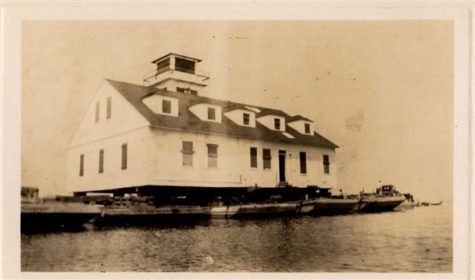FIRE ISLAND SUMMER CLUB is one of the lesser known of the 16 individual and distinct communities on Fire Island. It is located between Corneille Estates, a mere two-block walk from the infamous metropolis of Ocean Beach on the east, and the Fire Island National Seashore (FINS) on the west.The Summer Club was incorporated in 1946, making this its 70th anniversary. It was founded by members of the New York Athletic Club who envisioned a non-profit, private-membership, family community along the lines of Point O’ Woods, and was originally called The Fire Island Beach Club. It was organized to never be over-populated or commercialized, with all members bound by the rules and bylaws of the club.The community was initially divided into 79 lots with additional land reserved for a clubhouse and two tennis courts. The original 50 members were required to put up an initiation fee of $150 and pay annual dues of $50 a year. If they wanted to participate in the land development project they were required to ante up an additional $150.In the summer of 1947, it was determined that the cost of an individual lot would be $1,500 with a limit of two lots per member. Lots were leased for 99 years. Development was slow with only six homes completed by the end of 1947, two more in 1950, with an expectation of 10 more by the end of that year. Many of the lots remained vacant until the 1970s. Today there are 44 individual single-family homes, with rights to both ocean and bay beaches, bayside mooring for their boats and membership in their clubhouse.
The Remarkable History of the Summer Beach ClubhouseThe sale of 44 plots to 27 of the original members in the fall of 1946, along with option rights and additional assessments, provided the funds necessary to purchase the clubhouse, along with equipment, cement walkways and other needed improvements.The clubhouse was originally one of seven United States Life Saving Stations (USLSS) located about five miles apart along the length of Fire Island. It is said that an early club member, one Mr. Murphy – a Navy veteran – was instrumental in the purchase of the Blue Point station, which turned out to have quite a remarkable history.Throughout the early maritime history of America there were untold numbers of ship wrecks along the East Coast resulting in the loss of hundreds of lives and uncounted dollars worth of property. In order to aid these stricken vessels, their crews and passengers, several small buildings equipped with the most basic equipment and supplies were constructed. They were unmanned, but serviced by a volunteer force usually made up of baymen and farmers. As traffic increased along the East Coast, the USLSS was established in 1878, with stations located from Maine to North Carolina, and then on to Florida.Eventually these unmanned rescue shacks grew in size until by the turn of the century they housed a crew and often consisted of several buildings with the main structure sporting a lookout tower on the roof, as the photos that accompany this article illustrate. The seven USLSS located on Fire Island were the Fire Island Station, Point O’ Woods, Lone Hill (FI Pines), Blue Point (Water Island), Bellport, Smith Point and Forge River (Moriches Inlet).It was the Blue Point Coast Guard Station, built in 1913, that was purchased as the Summer Beach Club clubhouse and is the only one left in its original configuration, less modern improvements. One was incorporated into Flynn’s Hotel in Ocean Bay Park. These stations are responsible for aiding 721 vessels and saving 7,086 lives with the Blue Point Station responsible for approximately 80 of those rescues accord- ing to the Summer Club website (summerclubfi.com).Among the more harrowing stories of shipwrecks on Fire Island and one in which the Blue Point Station was directly involved, was that of the loss of both the Louis V. Place and John B. Manning, which took place over three days in February 1895. The story tells of frozen crew-members hanging in the rigging and the heroic attempts to save them. Seven men were lost, including the captain, and only one survived. You can read the complete story at greaterpatchoguehistoricalsociety.com
The Blue Point Station is also famous for the two gold lifesaving medals awarded by the U.S. Coast Guard to surfmen Frank B. Raynor and Albert Latham for their heroism in saving lives after the wreck of the schooner Benjamin C. Cromwell in February of 1904. These heroic men actually entered the freezing ocean in the middle of the winter and pulled survivors ashore.You can read all about that rescue by visiting www.uscg.mil/history.The USLSS stations were transferred to Coast Guard operations in 1915, and continued to operate through WWII after which the stations were decommissioned and declared government surplus. The Summer Beach Club purchased the Blue Point Station building for $3,500 dollars and floated it down the Great South Bay to its present location.Food was served on weekends through the ‘50s, and on Saturday nights in the ‘60s the clubhouse held dances including hosting Woody Allen’s jazz band.From the ‘50s through the ‘70s a boat basin and dock occupied property to the west of the clubhouse. This property was deeded to the National Park Service and is now a permanent part of the Fire Island National Seashore.Summer Club Condominiums – A Self-Managed CommunityIn the early 1990s, the name of the community was changed from the Fire Island Summer Club to Summer Club Condominiums. Today the bayfront clubhouse hosts social events each season and features a full-workout fitness center and gaming tables.Renovations on the clubhouse, including a new bar, will begin in the fall with an expectation of being completed by next spring. In addition, a new dock will be installed for use exclusively by the Summer Club residents – no ferries or water taxis will land there. The budget for these improvements is $400,000.What sets the Summer Club apart from other Fire Island communities is that it is organized as a self-governed condominium complex with strict rules run by a nine-member board of directors. The homes are own- er occupied with limited allowance for group rentals. No new two-story construction is permitted to maintain open spaces and views. The Summer Club has its own security on its beaches. They also have an electric golf cart to aid in transporting residents to and from the Ocean Beach ferry dock. This strong self-management has allowed the Summer Club to accumulate a substantial reserve fund, and keep maintenance low.Happy Anniversary Fire Island Summer Club!
































